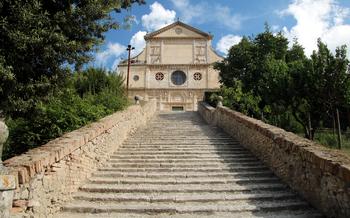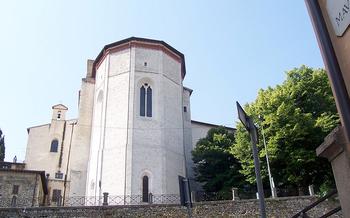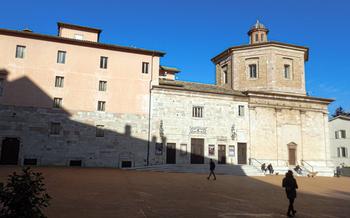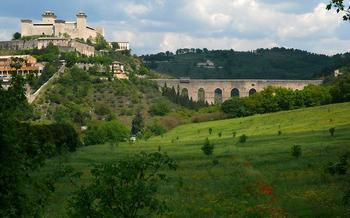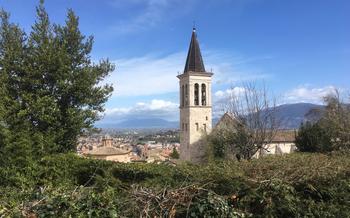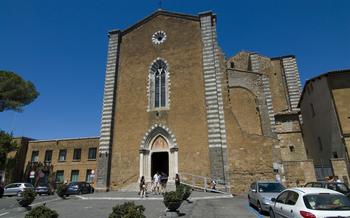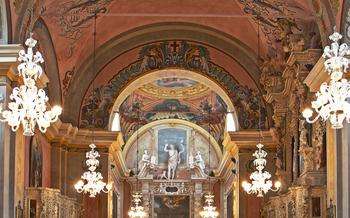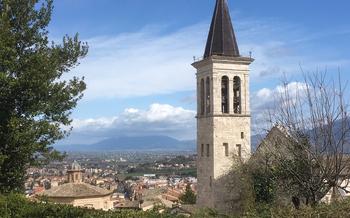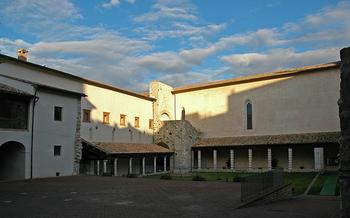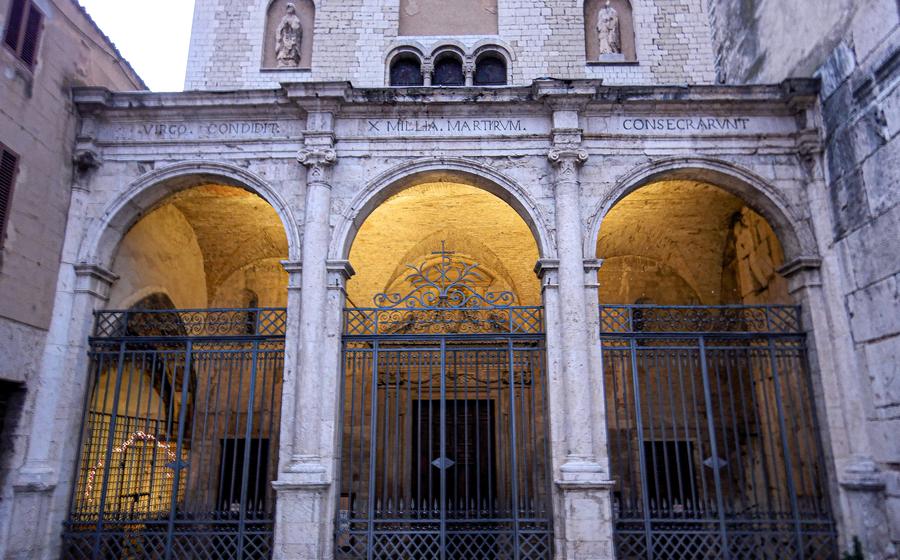
Chiesa di San Gregorio Maggiore
- A Majestic Testimony of History and Beauty: Exploring the Chiesa di San Gregorio Maggiore in Spoleto
- Historical Background
- Architectural Features
- Interior Decorations
- The Crypt
- The Cloister: A Haven of Serenity and History
- Religious Significance
- Cultural Importance
- Restoration and Preservation
- Things to See Nearby
- Events and Activities
- Local Cuisine and Dining
- Accommodation Options
- A Secret Revealed: The Hidden Treasure Beneath the Church
A Majestic Testimony of History and Beauty: Exploring the Chiesa di San Gregorio Maggiore in Spoleto
In the heart of the captivating Italian town of Spoleto, nestled amidst medieval alleys and timeworn structures, lies a hidden gem that beckons travelers to embark on a journey through history and art. The Chiesa di San Gregorio Maggiore, a testament to the fusion of architectural styles and religious devotion, stands as a beacon of spiritual and cultural heritage, inviting visitors to discover its many treasures. As you approach this architectural masterpiece, prepare to be awed by its imposing facade, a testament to the enduring legacy of centuries past.
Historical Background
The Chiesa di San Gregorio Maggiore holds a rich and storied past, deeply intertwined with the religious and historical tapestry of Spoleto. Founded in the 11th century under the patronage of the Benedictine order, the church initially served as a place of worship and community gathering for the monastic community. Over time, it evolved into a significant religious center, drawing pilgrims and faithful from across the region.
Throughout the centuries, the church has weathered various historical storms and undergone several renovations, each contributing to its distinct character. In the 13th century, it underwent significant modifications, transforming its architectural style from Romanesque to Gothic, resulting in the harmonious blend of styles visible today. These renovations reflected the changing tastes and artistic influences of the era, while preserving the church's essential character.
Despite numerous historical upheavals and changes in religious practices, the Chiesa di San Gregorio Maggiore has remarkably endured, standing as a testament to the enduring spirit and resilience of the Spoleto community. Through its unwavering presence, the church has become an integral part of the city's cultural and religious heritage, continuing to inspire and awe visitors with its timeless beauty and historical significance.
Architectural Features
The Chiesa di San Gregorio Maggiore stands out for its harmonious blend of Romanesque and Gothic architectural styles. The Romanesque elements are evident in the sturdy, round-arched entrance and the simple, geometric design of the exterior walls. In contrast, the Gothic influence is visible in the pointed arches and ribbed vaults of the interior, which lend a sense of height and grandeur to the space.
The church's facade is a masterpiece of simplicity and elegance. It features a central portal with a lunette containing intricate carvings depicting scenes from the life of Saint Gregory the Great. Above the portal, a delicate rose window adds a touch of ornamentation to the otherwise austere facade.
The church's bell tower, a later addition, stands tall and slender, its graceful silhouette piercing the Spoleto skyline. It features multiple arched windows and a pyramidal spire, creating a harmonious transition between the Romanesque and Gothic styles.
Inside, the church's interior layout follows a traditional basilican plan, with a central nave flanked by two aisles. The nave is divided into four bays by massive pillars that support the pointed arches and ribbed vaults. The apse, which houses the main altar, features a stunning fresco depicting the Last Judgment, a powerful reminder of the church's religious significance.
The transept, which intersects the nave at right angles, creates a distinct spatial division within the church. It houses two side altars dedicated to Saint Benedict and Saint Scholastica, and its walls are adorned with frescoes depicting scenes from their lives. The overall effect is one of awe-inspiring grandeur, creating a sacred space that invites contemplation and devotion.
Interior Decorations
The Chiesa di San Gregorio Maggiore is adorned with a breathtaking array of interior decorations that captivate the eyes and inspire the soul. The walls and ceilings are adorned with stunning frescoes, each a masterpiece of artistry and devotion. The intricate carvings and sculptures that embellish the interior further enhance the church's grandeur and elegance.
One of the most remarkable features of the church's interior is the series of frescoes depicting scenes from the life of Saint Gregory the Great. These frescoes, executed with exquisite detail and vibrant colors, bring to life the saint's miracles, his interactions with the faithful, and his unwavering dedication to his faith. The expressive faces and dynamic compositions of the figures create a sense of immediacy and connection with the viewer, drawing them into the narrative of Saint Gregory's life.
In addition to the frescoes, the church is also home to a collection of intricate carvings and sculptures that add to its visual splendor. The capitals of the columns, the corbels supporting the arches, and the reliefs adorning the walls and pulpits are all exquisitely crafted, showcasing the skill and artistry of the medieval craftsmen who created them. The intricate interlacing patterns, foliate motifs, and symbolic figures that adorn these carvings add depth and texture to the church's interior, creating a harmonious blend of architectural and artistic elements.
The symbolic meaning and stories depicted in the artwork of the Chiesa di San Gregorio Maggiore further enhance its significance. The frescoes and sculptures are not merely decorative elements but also serve as powerful tools for teaching and inspiration. They depict scenes from the Bible, stories of the saints, and moral allegories that were intended to educate and guide the faithful. The vivid imagery and compelling narratives of these artworks have played a vital role in shaping the religious and cultural identity of Spoleto throughout the centuries.
The Crypt
Beneath the Chiesa di San Gregorio Maggiore lies a hidden treasure—a crypt that has remained remarkably preserved through the centuries. Discovered during restoration work in the 20th century, the crypt offers a glimpse into the church's early history and religious significance.
The walls of the crypt are adorned with a series of well-preserved frescoes that depict scenes from the Bible and the life of Saint Gregory the Great. These vibrant paintings offer a glimpse into the artistic style and iconography of the early Middle Ages, providing valuable insights into the religious beliefs and practices of the time.
In addition to the frescoes, the crypt also contains a number of inscriptions and carvings that shed light on the church's history and its relationship with the Benedictine order. These inscriptions provide valuable information about the construction, renovation, and dedication of the church, as well as the names of its patrons and benefactors.
The crypt served as a burial site for prominent members of the Benedictine community, and several tombs and sarcophagi have been discovered within its walls. These tombs provide further evidence of the church's importance as a religious center and place of veneration.
Visiting the crypt is a unique opportunity to explore the hidden depths of the Chiesa di San Gregorio Maggiore and gain a deeper understanding of its historical significance. The crypt's well-preserved frescoes, inscriptions, and tombs offer a tangible connection to the past, providing visitors with a glimpse into the lives and beliefs of those who came before them.
The Cloister: A Haven of Serenity and History
Adjacent to the Chiesa di San Gregorio Maggiore lies a serene oasis – the cloister. This tranquil courtyard, enclosed by graceful arches and slender columns, invites visitors to step into a realm of contemplation and peace. Its elegant architecture, with its rhythmic interplay of arches and columns, creates a harmonious ambiance that echoes the spiritual essence of the church.
The cloister, with its well-manicured garden and soft natural light filtering through the arches, serves as an ideal retreat for reflection and introspection. Visitors can stroll along the covered walkways, marveling at the intricate details of the arches and columns, and immersing themselves in the tranquility of the surroundings.
In the center of the cloister, a verdant garden flourishes, adding a touch of life and color to the serene space. The gentle rustling of leaves and the sweet fragrance of blooming flowers create a sensory experience that complements the visual beauty of the cloister.
The cloister's historical significance is intertwined with that of the church itself. It has borne witness to centuries of religious devotion, serving as a place of gathering, meditation, and contemplation for the Benedictine monks who once called this sacred space their home.
Today, the cloister remains a cherished part of the Chiesa di San Gregorio Maggiore, offering visitors a glimpse into the contemplative lives of the monks and a sanctuary of peace amidst the bustling city. It is a place to pause, reflect, and connect with the spiritual essence that permeates this ancient site.
Religious Significance
The Chiesa di San Gregorio Maggiore holds immense religious significance as a sanctuary dedicated to Saint Gregory the Great, the renowned 6th-century Pope and Doctor of the Church. Saint Gregory's profound influence and legacy are deeply entwined with the history and spirituality of Spoleto. The church serves as a place of pilgrimage and veneration for devotees from around the world who come to pay homage to the saint and seek his intercession.
Within the church, visitors can venerate the relics of Saint Gregory, which are enshrined in a splendid reliquary positioned beneath the main altar. These sacred remains, believed to possess miraculous powers, have attracted countless pilgrims throughout the centuries. The church also houses a stunning collection of artworks depicting scenes from Saint Gregory's life and miracles, further enhancing its religious significance.
During special feast days and religious celebrations honoring Saint Gregory, the church becomes a vibrant hub of activity. Solemn masses, processions, and commemorative events draw large crowds of faithful who gather to celebrate the saint's life and teachings. These occasions provide a unique opportunity for visitors to immerse themselves in the spiritual traditions and devotion surrounding Saint Gregory.
Cultural Importance
The Chiesa di San Gregorio Maggiore stands as a testament to Spoleto's rich cultural tapestry. Its enduring presence has made it a beloved symbol of the city's heritage, drawing visitors from around the world. The church's architectural splendor and artistic treasures have earned it a place among Italy's most significant cultural landmarks.
As a center of religious devotion, the church has played a pivotal role in shaping Spoleto's spiritual and cultural identity. Throughout history, it has been a place of pilgrimage and a source of inspiration for countless believers. The church's association with Saint Gregory the Great, one of the most revered figures in Christian history, further enhances its cultural significance.
Moreover, the Chiesa di San Gregorio Maggiore has become a hub for promoting art and history. Its well-preserved frescoes, sculptures, and architectural features have made it a living museum, showcasing the artistic achievements of past centuries. The church regularly hosts exhibitions, concerts, and cultural events, attracting art enthusiasts and history buffs alike.
Recognizing its immense value, the Italian government has designated the Chiesa di San Gregorio Maggiore as a national monument. This prestigious status underscores the church's importance as a cultural asset and ensures its preservation for future generations. The ongoing efforts to restore and maintain the church are a testament to the community's commitment to safeguarding its cultural heritage.
Restoration and Preservation
The Chiesa di San Gregorio Maggiore has undergone several restoration and preservation projects to maintain its historical integrity. The challenges faced by conservators include the effects of time, wear, and environmental factors, which have caused damage to the frescoes, sculptures, and architectural elements of the church.
To address these challenges, experts have employed various techniques and methods to conserve the artwork and preserve the original features of the church. These techniques include careful cleaning, restoration of missing or damaged elements, and the application of protective coatings to prevent further deterioration.
The restoration efforts have focused on preserving the vibrant colors and intricate details of the frescoes, which are among the most significant artistic features of the church. Conservators have used a combination of traditional and modern techniques, such as laser cleaning and digital imaging, to restore the frescoes to their original splendor.
Preserving the Chiesa di San Gregorio Maggiore is of utmost importance, as it represents a valuable piece of Spoleto's cultural heritage. The ongoing restoration and preservation efforts ensure that this architectural gem can continue to be enjoyed and appreciated by future generations.
Things to See Nearby
In the immediate vicinity of the Chiesa di San Gregorio Maggiore, visitors can discover a wealth of additional attractions that offer a captivating glimpse into Spoleto's rich heritage. A short stroll from the church leads to the Piazza del Duomo, the heart of Spoleto's historic center. Here, visitors can marvel at the majestic Duomo di Spoleto, a splendid example of Romanesque architecture, and climb the Torre Campanaria for panoramic views of the city and the surrounding Umbrian countryside.
For art enthusiasts, the Museo Civico di Spoleto, housed in the Palazzo Racani Arroni, offers a fascinating collection of medieval and Renaissance paintings, sculptures, and artifacts. The museum's highlights include works by Pinturicchio, Filippino Lippi, and Perugino, providing a deeper insight into the artistic legacy of Spoleto and the Umbrian School.
Another must-see attraction near the church is the Teatro Nuovo di Spoleto, a beautiful 19th-century theater that hosts a variety of performances, including opera, ballet, and concerts. Visitors can take a guided tour of the theater to admire its elegant interior and learn about its history and cultural significance.
For those seeking a tranquil retreat, the Parco del Monteluco, located just outside Spoleto, offers a serene escape amidst nature. This enchanting park features lush forests, cascading waterfalls, and panoramic viewpoints, providing visitors with a chance to immerse themselves in the natural beauty of Umbria.
By combining a visit to the Chiesa di San Gregorio Maggiore with these nearby attractions, visitors can create a comprehensive and enriching itinerary that showcases the diverse cultural offerings of Spoleto. Whether you are interested in art, history, architecture, or nature, Spoleto has something to offer every traveler.
Events and Activities
The Chiesa di San Gregorio Maggiore is not just a historical site but also a vibrant cultural center that hosts various events and activities throughout the year. Visitors can participate in guided tours that delve into the church's history, architecture, and religious significance. These tours are led by knowledgeable guides who bring the church's stories to life and offer insights into its unique features.
For those interested in learning more about the church's artistic treasures, workshops and educational programs are occasionally organized. These events provide participants with hands-on experiences, such as fresco painting or calligraphy, allowing them to connect with the church's artistic heritage in a meaningful way.
The church also hosts concerts and musical performances, showcasing the works of talented local and international musicians. These concerts are held within the church's atmospheric interior, creating a truly immersive and unforgettable experience for music enthusiasts.
During religious holidays and special occasions, the church comes alive with processions, ceremonies, and celebrations. Visitors can witness the devotion and traditions of the local community as they participate in these events, gaining a deeper understanding of the church's spiritual significance.
Local Cuisine and Dining
A visit to Spoleto is not complete without savoring the delights of its local cuisine. The city offers a diverse culinary scene, with many restaurants and cafes located near the Chiesa di San Gregorio Maggiore. For a truly authentic experience, try Locanda del Principe, a charming establishment just a short stroll from the church. This family-run restaurant serves traditional Umbrian dishes prepared with fresh, seasonal ingredients. Indulge in their signature dish, Strangozzi al Tartufo, a pasta made with black truffles, or savor the Grigliata Mista, a mixed grill of local meats.
Another excellent option is Osteria del Centenario, known for its wood-fired pizzas and hearty pasta dishes. Sample their Pizza alla Norcina, topped with black truffles and sausage, or the Pasta alla Spoletina, a local specialty made with wild asparagus and Pecorino cheese. For a casual dining experience, head to Bar del Teatro, a popular spot for locals and tourists alike. Enjoy a light lunch of bruschetta or panini while soaking in the lively atmosphere of the city's historic center.
No visit to Spoleto is complete without trying the region's famous olive oil. Umbria is renowned for its high-quality olive oil, and Spoleto is home to several producers. Visit one of the local oleifici (olive oil mills) to learn about the production process and sample different varieties of oil. You can also purchase bottles of olive oil to take home as a souvenir or gift.
Accommodation Options
For a pleasant stay in close proximity to the Chiesa di San Gregorio Maggiore, visitors have a range of accommodation options to choose from. For those seeking a luxurious and indulgent experience, the Grand Hotel Spoleto, located just a short stroll from the church, offers elegant rooms, a rooftop terrace with panoramic views, and a renowned restaurant serving regional cuisine. For a more budget-friendly option, the Hotel Centrale, situated a few steps away, provides comfortable rooms with modern amenities and a complimentary breakfast. For those who prefer a home-like ambiance, numerous charming guesthouses and bed and breakfasts, such as La Casa di Nonna Rosetta, can be found in the vicinity, offering a cozy and authentic Italian experience. It is advisable to book accommodations in advance, especially during peak tourist season, to secure the best rates and availability.
A Secret Revealed: The Hidden Treasure Beneath the Church
Beneath the Chiesa di San Gregorio Maggiore lies a secret that few visitors know about - a hidden crypt that has been sealed off for centuries. Discovered during restoration work in the 19th century, the crypt is a treasure trove of well-preserved frescoes and inscriptions that offer a glimpse into the church's rich history. While it is not always accessible to the public, visitors who are fortunate enough to arrange a special tour will be rewarded with an unforgettable experience. The crypt is a testament to the enduring legacy of the church and the deep devotion of its followers.
